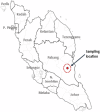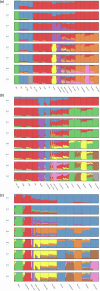High-coverage whole-genome sequencing of a Jakun individual from the "Orang Asli" Proto-Malay subtribe from Peninsular Malaysia
- PMID: 39774017
- PMCID: PMC11707147
- DOI: 10.1038/s41439-024-00308-6
High-coverage whole-genome sequencing of a Jakun individual from the "Orang Asli" Proto-Malay subtribe from Peninsular Malaysia
Abstract
Jakun, a Proto-Malay subtribe from Peninsular Malaysia, is believed to have inhabited the Malay Archipelago during the period of agricultural expansion approximately 4 thousand years ago (kya). However, their genetic structure and population history remain inconclusive. In this study, we report the genome structure of a Jakun female, based on whole-genome sequencing, which yielded an average coverage of 35.97-fold. We identified approximately 3.6 million single-nucleotide variations (SNVs) and 517,784 small insertions/deletions (indels). Of these, 39,916 SNVs were novel (referencing dbSNP151), and 10,167 were nonsynonymous (nsSNVs), spanning 5674 genes. Principal Component Analysis (PCA) revealed that the Jakun genome sequence closely clustered with the genomes of the Cambodians (CAM) and the Metropolitan Malays from Singapore (SG_MAS). The ADMIXTURE analysis further revealed potential admixture from the EA and North Borneo populations, as corroborated by the results from the F3, F4, and TreeMix analyses. Mitochondrial DNA analysis revealed that the Jakun genome carried the N21a haplogroup (estimated to have occurred ~19 kya), which is commonly found among Malays from Malaysia and Indonesia. From the whole-genome sequence data, we identified 825 damaging and deleterious nonsynonymous single-nucleotide polymorphisms (nsSNVs) affecting 720 genes. Some of these variants are associated with age-related macular degeneration, atrial fibrillation, and HDL cholesterol level. Additionally, we located a total of 3310 variants on 32 core adsorption, distribution, metabolism, and elimination (ADME) genes. Of these, 193 variants are listed in PharmGKB, and 21 are nsSNVs. In summary, the genetic structure identified in the Jakun individual could enhance the mapping of genetic variants for disease-based population studies and further our understanding of the human migration history in Southeast Asia.
© 2025. The Author(s).
Conflict of interest statement
Competing interests: The authors declare no competing interests. Ethics approval and consent to participate: This study was approved by the Research and Ethics Committee of Universiti Teknologi MARA [Ref no: 600-RMI (5/1/6)] and the Department of Orang Asli Development (Jabatan Kemajuan Orang Asli Malaysia, JAKOA) [JHEOA.PP.30.052. Jld 5(17)]. The subject consented to participate in this study.
Figures




Similar articles
-
Analysis of five deep-sequenced trio-genomes of the Peninsular Malaysia Orang Asli and North Borneo populations.BMC Genomics. 2019 Nov 12;20(1):842. doi: 10.1186/s12864-019-6226-8. BMC Genomics. 2019. PMID: 31718558 Free PMC article.
-
Genomic structure of the native inhabitants of Peninsular Malaysia and North Borneo suggests complex human population history in Southeast Asia.Hum Genet. 2018 Feb;137(2):161-173. doi: 10.1007/s00439-018-1869-0. Epub 2018 Jan 30. Hum Genet. 2018. PMID: 29383489
-
A genome wide pattern of population structure and admixture in peninsular Malaysia Malays.Hugo J. 2014 Dec;8(1):5. doi: 10.1186/s11568-014-0005-z. Epub 2014 Oct 30. Hugo J. 2014. PMID: 27090253 Free PMC article.
-
The genetic history of Peninsular Malaysia.Gene. 2016 Jul 15;586(1):129-35. doi: 10.1016/j.gene.2016.04.008. Epub 2016 Apr 7. Gene. 2016. PMID: 27060406 Review.
-
Insight of the mitochondrial genomes of the Orang Asli and Malays: The heterogeneity and the disease-associated variants.Mitochondrion. 2022 Jan;62:74-84. doi: 10.1016/j.mito.2021.10.010. Epub 2021 Nov 5. Mitochondrion. 2022. PMID: 34748985 Review.
References
-
- Bellwood, P. Prehistory of the Indo-Malaysian Archipelago. 3rd ed (University of Hawaiʼi Press, Honolulu, Hawaii, 2007).
-
- Habibah, A., Hamzah, J. & Mushrifah, I. Sustainable livelihood of the community in Tasik Chini biosphere reserve: the local practices. J. Sustain Dev.3, 184 (2010).
-
- Masron, T., Masami, F. & Ismail, N. Orang Asli in Peninsular Malaysia: population, spatial distribution and socio-economic condition. J. Ritsumeikan Soc. Sci. Humanit.6, 75–115 (2013).
-
- Liu, X. et al. Differential positive selection of malaria resistance genes in three indigenous populations of Peninsular Malaysia. Hum. Genet.134, 375–392 (2015). - PubMed
LinkOut - more resources
Full Text Sources
Miscellaneous

